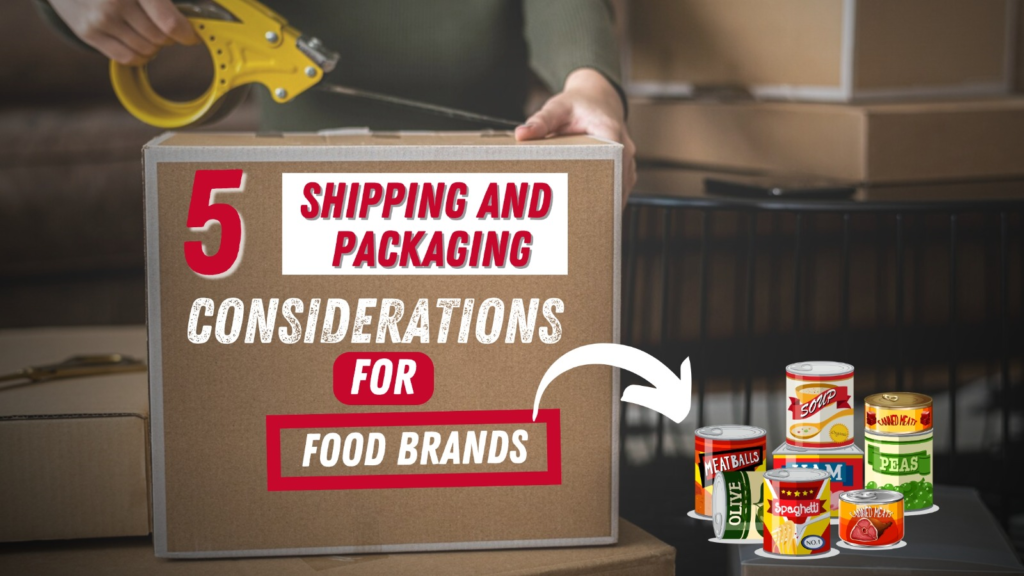
As a food brand, shipping and packaging are crucial aspects of your business. Not only do they ensure that your products arrive at their destination safely and efficiently, but they also play a significant role in maintaining product quality, preventing contamination, and building customer trust.
In fact, research has shown that packaging plays a critical role in consumer purchasing decisions, with 72% of consumers saying that packaging design influences their buying decisions. Moreover, effective packaging can help reduce food waste, minimize environmental impact, and enhance your brand’s reputation.
Read More: 5 Reasons Why Your Business Needs Custom Packaging for Shipping Boxes
In this blog, we will explore five essential shipping and packaging considerations for food brands. From temperature control to labelling and traceability, we will look into the key factors that can make or break your food shipping and packaging strategy.
The Importance of Effective Packaging in the Food Industry
Effective packaging is critical in the food industry, where products are perishable and sensitive to environmental factors such as temperature, humidity, and light. Packaging not only protects products from damage and contamination but also plays a crucial role in maintaining product quality, freshness, and safety. In addition, packaging can help reduce food waste, minimize environmental impact, and enhance your brand’s reputation.
In the following section, we will explore five essential shipping and packaging considerations for food brands.
5 Shipping and Packaging Considerations for Food Brands
When it comes to shipping and packaging food products, there are several key considerations that food brands must take into account to ensure that their products arrive at their destination safely and efficiently.
However, by understanding the key considerations and taking the necessary steps to address them, food brands can build customer trust, maintain product quality, and prevent contamination and foodborne illness. These considerations are:
Consideration 1: Temperature Control
Temperature control is critical when shipping perishable food items. Failure to maintain the proper temperature can result in product spoilage, contamination, and even foodborne illness. Food brands must invest in temperature-controlled packaging solutions, such as insulated boxes, gel packs, or dry ice, to ensure that their products remain at the required temperature during transit. This is especially important for products like meat, dairy, and frozen foods, which require specific temperature ranges to stay fresh.
Consideration 2: Humidity Control
Humidity control is another vital aspect of shipping and packaging for food brands. Moisture can cause products to become stale, develop off-flavours, or even grow mould and bacteria. Food brands must use packaging materials that are resistant to moisture, such as foil or plastic wrap, and consider using desiccants to absorb any excess moisture. This is especially important for products like baked goods, snacks, and coffee, which are sensitive to moisture.
Consideration 3: Sanitation and Hygiene
Sanitation and hygiene are paramount when shipping food products. Food brands must ensure that their packaging materials are clean and sanitized to prevent contamination. This includes using food-grade packaging materials, cleaning and sanitizing packaging equipment regularly, and training staff on proper sanitation and hygiene procedures. Additionally, food brands must ensure that their packaging materials are free from any contaminants, such as chemicals or allergens, which could harm consumers.
Consideration 4: Product Protection
Product protection is essential to prevent damage during transit. Food brands must use packaging materials that are sturdy and durable, such as cardboard or plastic containers, and consider using cushioning materials like bubble wrap or foam inserts to prevent product movement and shock. This is especially important for products like glass jars or fragile snacks, which require extra protection to prevent breakage.
Consideration 5: Labeling and Traceability
Labelling and traceability are critical for food brands to ensure compliance with regulations and to maintain customer trust. Food brands must label their products with essential information such as ingredients, allergens, and expiration dates.
Additionally, they must implement traceability measures to track their products throughout the supply chain, enabling quick recall and response in case of contamination or product defects. This includes using barcodes, RFID tags, or other tracking technologies to monitor products from production to delivery.
Additional Considerations
In addition to these five essential considerations, food brands must also think about the following:
- Sustainability: Food brands must consider the environmental impact of their packaging materials and choose sustainable options whenever possible.
- Branding: Packaging is an opportunity for food brands to showcase their brand identity and build customer loyalty.
- Regulations: Food brands must comply with regulations such as FDA guidelines or EU food safety standards.
- Customer expectations: Food brands must meet customer expectations for packaging, including convenience, ease of use, and product protection.
Conclusion
In conclusion, shipping and packaging are critical components of the food supply chain. Food brands must consider temperature control, humidity control, sanitation and hygiene, product protection, and labelling and traceability to ensure that their products arrive at their destination safely and efficiently.
By investing in the right packaging solutions and procedures, food brands can build customer trust, maintain product quality, and prevent contamination and foodborne illness. Additionally, by considering sustainability, branding, regulations, and customer expectations, food brands can stay ahead of the competition and build a successful business.
